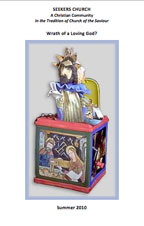
July 18, 2010
In the format of an InterPlay technique called The Big Story, Kate shared images and impressions from her trip to the Holy Land over Holy Week 2010. Beginning with the trepidations of going somewhere she didn’t really want to go, a little scared for her safety she made the trip. She played out the stress in her body as she told of the dog that barked incessantly that they heard from their hotel room in Bethlehem – the dog that only stopped when the imam wrapped the whole city in the call to prayer. The dog barking was joined by the cock crowing three times which brought her right into the story of Peter denying Jesus. The sights and sounds of Good Friday, walking the Via Dolorosa with the people of many nations in their costumes, and the miracle of new light televised nationally on Holy Saturday. When referring to the reading from Amos and the basket of summer figs, Kate enacted and spoke of the nature of figs to be the sweetest and most wonderful fruit or the most rotten, the tension between the two realities, and how this is a metaphor for our own lives.
Kate writes:
In April, on Maundy Thursday, I arrived in Bethlehem. Billy is doing
a project to improve the health of children on the West Bank and
Gaza. He invited me to accompany him. I had not wanted to go to the Holy Land, especially not during Holy Week. I feared the crowds and the possibility of violence. In my mind, the intensity of religious sentiment in the Middle East made that region of the world a place to be avoided. Nonetheless, on the Thursday of Holy Week, I found myself going through the intense scrutiny of the many security checkpoints at Dulles airport as I boarded a plane to Tel Aviv. Billy met me when I arrived in Israel and we headed for our hotel.
From the beginning, my experience of the Holy Land was one of holding opposite realities. Bethlehem is a small dusty Palestinian town on the West Bank. Our hotel was a converted nineteenth century palace built by a wealthy Palestinian tradesman. It was grand and impersonal. We were there to see if it could be the site of the Foundation’s board meeting in the fall. The view from our window was one of broken buildings, rubble, and chicken coops, all of which were part of Aida Camp, a Palestinian refugee camp, which had been created in 1956. The next morning we began our day with a seemingly sumptuous but tasteless breakfast at the hotel and ended the day with a seemingly simple but delicious meal with some Palestinian friends in Aida Camp.
One of the scriptures for today is from the prophet Amos. He tells his listeners that the Lord showed him a basket of ripe figs. This basket of fruit was an image to describe Israel. In the 8th century BC, Israel was very prosperous. The wealthy were becoming richer and the poor were becoming poorer. By manipulating credit and debt, the large landowners were acquiring the farms of the small landowners. Ripe fruit can be very sweet or very rotten. While the message of doom that Amos was preaching to the people of Israel was one of chastisement for exploiting the poor, the message that we can take from Amos is one of hope. We are descended from a religious tradition that chose to include Amos’ message in its sacred texts. Our faith is like the basket that holds the sweet and rotten fruit. We are also invited in our lives to hold the sweet and rotten fruit. Can we hold both that which is joyful and that which is painful without having to distract ourselves or shut down? Can we see the good and the bad both in ourselves and in others all at the same time? This Sunday I explored this theme as I experienced it during this Holy Week using a form called a big body story from the practice of InterPlay — so I invite you to talk to someone who was there if you want to know more.